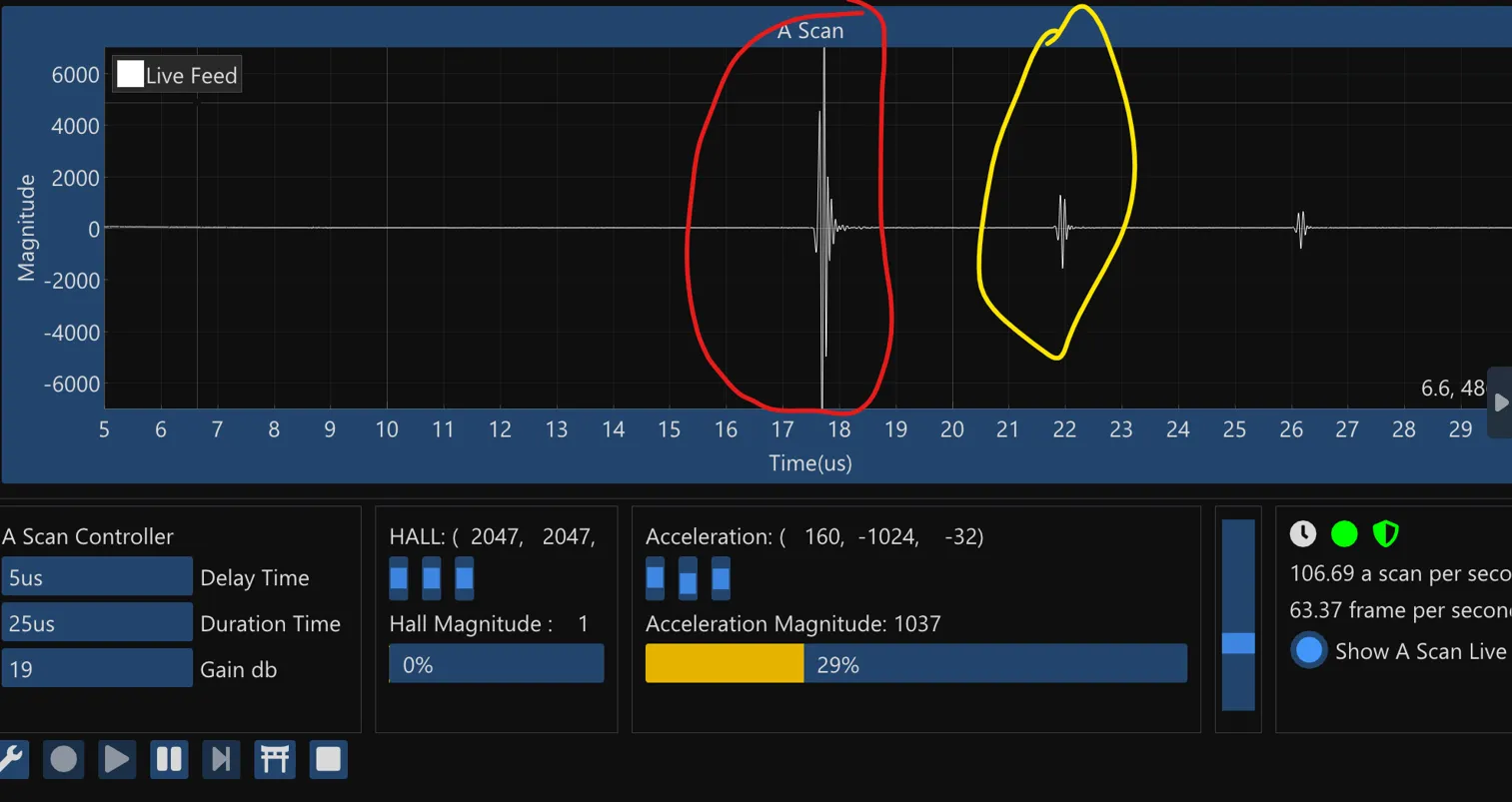Ultrasonic Calibration (Gating Algorithm)
Here is an example gate_config.json file:
{
"gating_config": {
"autogain_max_ampl": 0.7,
"find_gate_relative_to_first_interface": false,
"gate_duration": "5us",
"gate_offset": "400ns",
"interface2_offset": "500ns",
"search_begin": "5us",
"search_window_initial_gain": 1.0,
"search_window_size": "15us"
},
"gating_tolerance": {
"cap_begin_tolerance": "12ns",
"cap_end_tolerance": "12ns",
"repeat_times": 3,
"time_between_checks": "20ms"
}
}
note
gate_duration is not relevant in many applicatation, as this is often made obsolete because the A-Scan length is determined by the stack size.
It is recommended to use these settings, but below are some tips to change them yourself.
Gate Finding Algorithm
This diagram describes how the Gate Finding Algorithm works.

Interface 1 is circled in red and Interface 2 in yellow. Interface 1 corresponds to the inner face of the electrode cap and Interface 2 corresponds to the outer tip of the electrode cap. The purpose of the Gate Finding Algorithm is to find these interfaces and use them to set the gates, gates refer to the area of A-Scan that we use to image the weld.
Configuration Variables
| Variable | Meaning |
|---|---|
autogain_max_ampl | When Interface 2 is found, we find it useful to make the interface larger, we do this by increasing the gain of interface 2 so that it is a certain fraction of Interface 1 (in our case above interface 2 will be set to 70% of the gain of interface 1) Normally this variable has little affect on the success rate of the algorithm but this can affect B-Scan resolution. |
find_gate_relative_to_first_interface | This should always be false; this is set true for some research purposes but, this is not relevant for our purposes. It sets the gates before Interface 1 instead of before Interface 2. |
gate_duration | This determines the size of the gates, but like what is stated above, this is not relevant in many cases as it gets over-written. |
gate_offset | Determines how far behind Interface 2 to set the delay of A-Scan capture. In practice it determines the head room of the B-Scan. |
interface2_offset | In a sense determines the acceptable "thickness" of Interface 1, this value determines how far passed the specific point that Interface 1 was set as to begin searching for Interface 2. |
The next 3 variables are of significant importance!
| Variable | Meaning |
|---|---|
search_begin | This determines the beginning of the range where the interfaces will be searched, this value must be earlier than Interface 1. Also known as registration delay. |
search_window_initial_gain | The gain used to search for the interfaces changes through out the algorithm, but this value is where the algorithm starts, It should not be too large, but if the signal is not healthy than a small value may be detected as noisy. 1 worked in most cases but you could try larger values. Use the gain setting on the oscillograph to what the smallest value is to be able to observe the interfaces easily (the image above shows a good signal). |
search_window_size | This is the length of the range past "search_begin" that was be used to find the interfaces. Interface 1 and Interface 2 both must be visible on the range [ "search_begin" , "search_begin" + "search_window_size"]. Use the Oscillograph to verify this. |